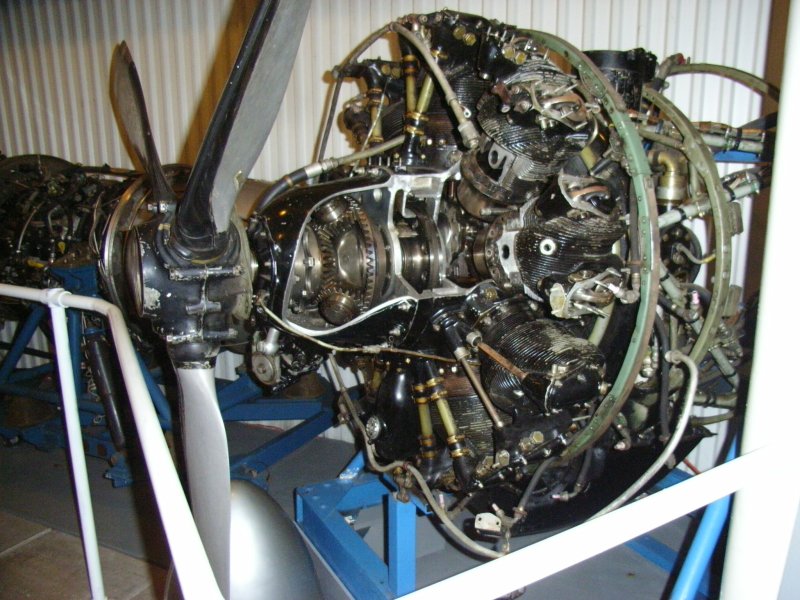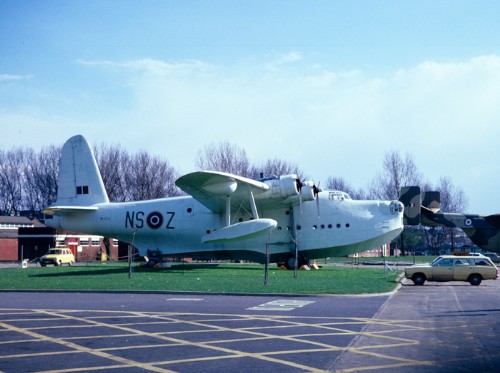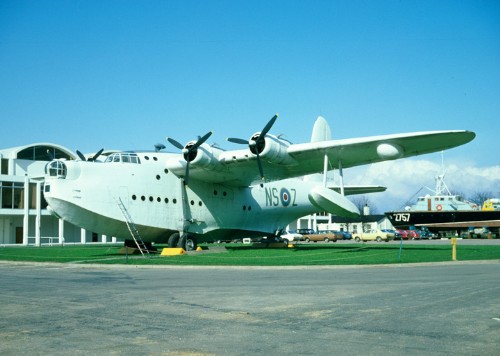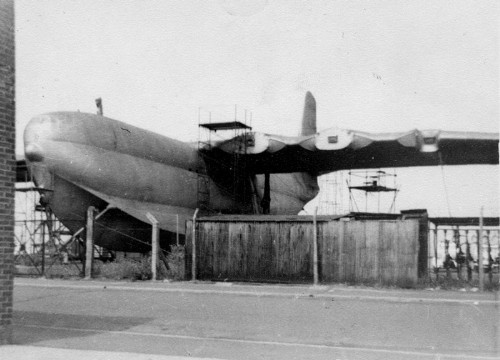| Author |
 Topic Topic  |
|
Tizer
|
 Posted -
21/12/2007
:
11:56 Posted -
21/12/2007
:
11:56
|
I have uploaded my first picture to the Barlick site I hope to be able to add it in this thread if/when it gets approval from Doc. It is a postcard from the 1940s entitled Winged Heroes and showing Hawker Hurricanes. (The picture is in the next post if you are on page 1 of the thread; if you are on another page you need to go back tp page 1 to see it.)
Please feel free to add your own stories, pictures or comments regarding everything to do with aeroplanes and their pilots, both past and present.
Edited by - Tizer on 11/11/2010 15:11:42
|
|
| Replies |
| Author |
|
|
Ringo
Site Administrator
 

3793 Posts

|
|
 Posted - 10/01/2008 : 09:22 Posted - 10/01/2008 : 09:22
quote:
Tizer wrote:

This photo is of an aeroplane engine which has been cut open to show the inside works. It is displayed at the Southampton Hall of Aviation, UK. I took the photo myself but regret that I did not note the engine type! I presume it is a radial engine and probable 1930s or earlier. A number of other engines are on show at the museum and there are photos of them on the web site but I could not see this one among them.
Further details of the museum are available at http://www.spitfireonline.co.uk
It could be a Alvis Leonides 128
http://www.rafmuseum.org/rafmdevelopment/cosford/collections/engines/engine_info.cfm?engine_id=1
 |
Tizer
|
 Posted - 10/01/2008 : 09:57 Posted - 10/01/2008 : 09:57
RR, I took another look at the Alvis engine and you are almost certainly correct - thanks for the help. After posting but before seeing your post, I sent an email to the museum asking them the identity of the engine. So I'll wait until they reply and see what they say - if they say Alvis Leonides Major, I will ask them about the 9 versus 7 cylinder problem. You might have done them a favour!
How strange about the Finnish Gauntlet having the Alvis Leonides engine. When I was loading the engine graphic to OGFB I thought "Wouldn't it be odd if the Gauntlet used this engine" - but immediately rejected it as wishful thinking.
You prompted me to look further on the Web for links between Gauntlets and the SAAF and I too found them; e.g. "One ex-RAF Gauntlet Mk I (870) and three ex-RAF Gauntlet IIs (871 to 873) were supplied to the SAAF for use in East Africa. A further four were received for use as ground instructional airframes (ex-RAF K4088, K4099, K4100 and K5331)."
Coincidentally, I also found this on "Sailor" Malan, a South African who became a WWII fighter ace in the RAF (but it relates to Gauntlets in the RAF, not SAAF): "...as a Flight Commander ["Sailor" Malan], soon developed qualities of leadership which were amply demonstrated when, in November, 1938, he trained and led his Flight to win the Sassoon Flight Attack Trophy, which was then the most coveted award in the Royal Air Force's Fighter Command. This he achieved in obsolete Gauntlet bi-planes in the face of competition from twenty-three other squadrons, several of which were equipped with the new eight-gun Hurricane monoplane, some hundred miles an hour faster than the elderly Gauntlet."
 |
Tizer
|
 Posted - 10/01/2008 : 10:02 Posted - 10/01/2008 : 10:02
Stanley, all you need now is the rest of the aeroplane to go with it! (By the way you can hire a Spitfire from the Southampton museum to stand in your garden.)
Ringo, thanks for the additional info which I hadn't seen when I replied to RR. I once went to an Alvis Car Owners' Club meeting at Duxford. It was the first time I had seen a one-make Owners' Club line-up that featured cars, armoured cars, tank and aircraft - though I suppose Rolls Royce could do the same.
Edited by - Tizer on 10/01/2008 10:09:07
 |
Stanley
Local Historian & Old Fart
    

36804 Posts

|
|
 Posted - 11/01/2008 : 08:32 Posted - 11/01/2008 : 08:32
I've got enough memorabilia here! My daughters are going to have a field day when I die!
Re. radial engines. I once saw a very interesting TV film about C47/Dakots planes still being used in Africa and being kept going by parts released by the US from their graveyards in the desert and local mechanics and blacksmiths working in unbelievably primitive conditions in the open. In particular there was one man with some crude tools doing a complete strip down and overhaul of a radial engine on the dirt floor. He was making replacement parts for the valve gear out of piano wire..... You had to admire the skill. The programme said that the reliabilty of the old planes was very high. I once remember my mate John Robinson telling me about flying in one full of chickens and he said you could see the sun shining in through the missing rivets........
Stanley Challenger Graham

Barlick View
stanley at barnoldswick.freeserve.co.uk  |
Tizer
|
 Posted - 11/01/2008 : 09:52 Posted - 11/01/2008 : 09:52
As you will know, the backstreet mechanics in Cuba and India do similar great work keeping old cars on the road. It makes our attempts at recycling look irrelevant. And I read a journalist's description of how you could take a Nissan flatbed truck into one of many small village workshops in Afghanistan and pick it up the following morning after conversion to a mobile gun platform with something like an anti-aircraft gun on the back.
 |
softsuvner
|
 Posted - 12/01/2008 : 11:26 Posted - 12/01/2008 : 11:26
The thing with old aircraft, like old vehicles, is that you can repair them with very basic materials, and basic facilities.
The airframe of a plane can be bodged up indefinatley, if you have a supply of sheet a/c grade alloy, a pop- rivet gun and loads of pop rivets.
It is no coincidence that long-term survivors like the C47/Dakota had old-type radial engines. These are old-style automobile technology, and lightly stressed for the work that they do. Civil aircraft that used the more complex highly-stressed engines, like the Avro York which used Merlin engines, didn't have a long career.
The aircraft industry spent years looking for "Dakota replacements" and there were many attempts like the Handley Page Herald and the Fokker F27. But they used turbo prop engines (mini jet turbines). These are not something that you can bodge up that easily. In today's world, when the computer that runs the engine on your 4 X 4 packs up in the middle of the desert, you can't repair it with a voltmeter and a coil of copper wire!
Malcolm
 |
Ribble Rouser
|
 Posted - 12/01/2008 : 13:28 Posted - 12/01/2008 : 13:28
Hear hear, Malcolm. The world of inbuilt redundancy, gone mad...in just about everything. Unsustainable.
it's bums that count 'ere; not 'ats  |
Stanley
Local Historian & Old Fart
    

36804 Posts

|
|
 Posted - 12/01/2008 : 17:36 Posted - 12/01/2008 : 17:36
I remember hearing Laker talking once and he said that the world needed a replacement for the Dakota. I have half an idea that someone tried to get one built some time in the 60s?
Stanley Challenger Graham

Barlick View
stanley at barnoldswick.freeserve.co.uk  |
Ribble Rouser
|
 Posted - 13/01/2008 : 01:07 Posted - 13/01/2008 : 01:07
The DHC-4 Caribou might lay claim to have replaced the C-47/Dakota in some specialist military supply roles on a small scale. It has certainly had a long service history, having first flown in 1958 and still being used by the RAAF and several civil operators world wide. It is known for its dramatic STOL capabilities (and it can taxi backwards) and is very rugged, enabling it to operate on primitive air strips in remote locations. It is the last piston-engined aircraft in service with the RAAF. As Malcolm points out, this has probably contributed to its longevity and durability. Its sister aircraft, the DHC-5 Buffalo, powered by turboprop units, was not nearly as successful, only 2 remaining operational. From the RAAF history page: The Caribou has been employed on “famine-relief operations in Papua New Guinea and Irian Jaya during Operations SIERRA, PLES DRAI and AUSINDO JAYA, as well as the tsunami-relief operation in PNG in 1999 and operations in East Timor and the Solomon Islands.” I’ve been lucky enough to have had several flights in one of these aircraft and utilitarian is the only way to describe its interior…the seating is webbing benches arrayed longitudinally along the sides of the fuselage. On the last occasion, I sat up with the pilot (well into his 40s) and had a long chat about his flying, and a more contented and fulfilled fellow I have never met. He really enjoyed the fact that his aircraft operated semi independently, supplying out of the way scientific stations and villages in the PNG Highlands, requiring seat-of-the-pants flying. He loved his old bus and told me he had the best job in the Air Force. One traverses my sky every now and then, hanging there like a sedated giant pelican, taking its time, a contented burble coming from the motors.
Edited by - Ribble Rouser on 13/01/2008 01:09:26
Edited by - Ribble Rouser on 13/01/2008 01:10:33
it's bums that count 'ere; not 'ats  |
Stanley
Local Historian & Old Fart
    

36804 Posts

|
|
 Posted - 13/01/2008 : 09:39 Posted - 13/01/2008 : 09:39
I have a wonderful book 'Douglas Propliners. DC1 - DC7' By a Yorkshireman, Arthur Pearcey. If you want to know anything about Dakotas, this is the place.... I once knew a woman in NY who was one of the first arline stewardess's in the days when they all had to be registered nurses. She once told me that the beauty of the DC4 was that it was the first plane she evr worked on where they didn't have to push the drinks trolley uphill in pencil skirts. She also had some good stories about 707s..... Her first job was on transatlantic flights in fying boats, the first regular transatlantic commercial service. There's another book, 'Wide Body' by Clive Irving. It's the story of the development of the 747, a must if you are interested in these things. I always wondered why the pilots cabin was perched so high up. It was because in order to make it saleable they were considering a freight version where the nose hinged up so they needed the cabin high up out of the way......
Stanley Challenger Graham

Barlick View
stanley at barnoldswick.freeserve.co.uk  |
Tizer
|
 Posted - 13/01/2008 : 11:07 Posted - 13/01/2008 : 11:07
Talking of flying boats.....The museum at Southampton that I mentioned above (Spitfire cockpit photo) has an example which you can enter and view the cabins. Details from museum web site:
******************
Short S.25/V Sandringham 4 - VH-BRC Beachcomber
This aircraft was originally built by Short Brothers at Rochester as a standard Sunderland Mk.III general reconnaissance flying-boat with the serial number JM715.
After the war Shorts devised a passenger carrying conversion of the Sunderland which they called the Sandringham and in March 1946 the company received an order from Tasman Empire Airways Ltd. (TEAL) of New Zealand. JM715 was purchased from the Air Ministry for conversion. After conversion at Short's Belfast factory the aircraft was allocated the conversion number SH.55C and registered to TEAL, delivered from Southampton to Waitemata Harbour, Auckland on 29th October 1947 and was soon in service on the 1300-mile Sydney- Auckland route. In May 1950 ZK-AMH, was sold to Barrier Reef Airlines of Australia where it was renamed Beachcomber. Barrier Reef Airlines were subsequently taken over by the major Australian airline Ansett and became Ansett Flying Boat Services.
Unfortunately the vast amounts of money required to keep the aircraft in flying condition were not available and in 1981 the aircraft was purchased for the National Aeronautical Collection by the Science Museum with the aid of a grant from the Heritage Trust and it was moved across Southampton Water to HMS Daedalus, RNAS Lee-on-Solent. The next year arrangements were made to house it in the new museum then being established by the R J Mitchell Memorial Museum. The aircraft was then dismantled, cleaned, repainted and moved to the, then uncompleted, museum building. When the building was finished it was reassembled in time for the museum opening in June 1983.
************************
Another good place for pictures of flying boats is the museum in a Martello tower at Pembroke Dock (put museum martello pembroke into Google for a picture and details of the museum). If you visit you will enjoy the pictures on the walls and the artefacts. But make sure you ask to see the other pictures from down below behind the counter (nudge, nudge, wink, wink!). When my wife and I were there, the two elderly ladies in charge realised we had a serious interest and they started to reminisce about the days during WWII when Milford Haven was full of flying boats. They brought out aerial photos and proved that the Haven was crowded with them. I didn't know there had been so many.
 |
softsuvner
|
 Posted - 13/01/2008 : 19:49 Posted - 13/01/2008 : 19:49
Somewhere, I must have some DC3 photos from the far off days when, after a night shift, I would take a walk out amongst the planes with my pocket camera. There are any number of reasons why I can't do that now!
In the meantime, here are some flying boat pictures from my collection:


These are of the R.A.F. Museum Sunderland taken 30 years ago before, quite rightly, she was moved inside.
The other two are not good quality pictures, but I include them because of their rarity.

This is the only one of the three Saunders Roe Princess Flying Boats that actually made it into the air. At the time it was thought that these large flying boats were the future for long-distance air-travel. By the time she flew, the jet age had dawned and there were no takers. She ended her days as shown, laid up in a boatyard in Cowes.
I well remember the day when we took the photo, we returned to the ferry via the steam-worked Cowes branch, long gone. It was a very hot day and the points had jammed at Cowes station, so we had to walk down the track to the train! The Cowes branch and the Princess Flying boats were reduced to scrap in the same year.....1967.

All 3 Princess Flying Boats were assembled at the old RNFS seaplane base at Calshot Spit on Southampton Water. The two incomplete airframes only left the site in scrap lorries. This rather poor snapshot (taken from the paddle steamer Princess Elizabeth) shows them at Calshot. The whole project allegedly costs the taxpayer £10,000,000 at 1950's prices. But then hindsight is a great thing, and even Howard Hughes made the same mistake!
Malcolm
 |
softsuvner
|
 Posted - 13/01/2008 : 19:51 Posted - 13/01/2008 : 19:51
This is a new one, never had this before, why have my photos been reduced to thumbnails?
Help!
 |
softsuvner
|
 Posted - 13/01/2008 : 20:01 Posted - 13/01/2008 : 20:01
Okay, I've cracked it, I copied the URL's from the thumbnail instead of the full picture, try again.

 |
softsuvner
|
 Posted - 13/01/2008 : 20:03 Posted - 13/01/2008 : 20:03



That's Better
Malcolm
 |